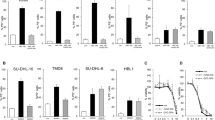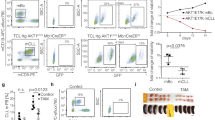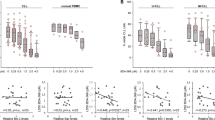Abstract
Tyrosine kinases of the Src family have been implicated in key biological processes. Here, we provide evidence that p56Lck, a lymphoid-specific Src kinase, is involved in the activation of the mitochondrial apoptosis pathway. Lck-deficient T cells were completely resistant to anticancer drugs. In contrast, apoptosis sensitivity to death receptors was not altered, indicating a specific interference of Lck with the mitochondrial pathway. Re-expression of Lck restored sensitivity to drug-induced apoptosis and triggered mitochondrial cytochrome c release and caspase activation. Further analysis identified that the sensitization by Lck was independent of classical mediators of T-cell signaling, but essentially involved the Bcl-2 protein Bak. Expression of Bak was completely absent in Lck-deficient cells, while re-expression of Lck transcriptionally triggered Bak expression and conferred sensitivity to apoptosis, associated with a proapoptotic conformational change of Bak. Furthermore, in vitro the truncated fragment of Bid specifically activated Bak and cytochrome c release only from mitochondria of Lck-expressing cells. These results do not only demonstrate a sentinel role of Lck in drug resistance but also delineate a hitherto unknown pathway of Src kinases in regulation of Bcl-2 proteins.
This is a preview of subscription content, access via your institution
Access options
Subscribe to this journal
Receive 50 print issues and online access
$259.00 per year
only $5.18 per issue
Buy this article
- Purchase on Springer Link
- Instant access to full article PDF
Prices may be subject to local taxes which are calculated during checkout








Similar content being viewed by others
References
Antonsson B, Conti F, Ciavatta A, Montessuit S, Lewis S, Martinou I et al. (1997). Science 18: 370–372.
Bantel H, Sinha B, Domschke W, Peters G, Schulze-Osthoff K, Janicke RU . (2001). J Cell Biol 155: 637–648.
Battle TE, Frank DA . (2002). Curr Mol Med 2: 381–392.
Belka C, Marini P, Lepple-Wienhues A, Budach W, Jekle A, Los M et al. (1999). Oncogene 18: 4983–4992.
Cartron PF, Juin P, Oliver L, Martin S, Meflah K, Vallette FM . (2003). Mol Cell Biol 23: 4701–4712.
Cheng J, Haas M . (1990). Mol Cell Biol 10: 5502–5509.
Cory S, Huang DC, Adams JM . (2003). Oncogene 22: 8590–8607.
Daniel PT, Schulze-Osthoff K, Belka C, Guner D . (2003). Essays Biochem 39: 73–88.
Datta SR, Brunet A, Greenberg ME . (1999). Genes Dev 13: 2905–2927.
Degenhardt K, Chen G, Lindsten T, White E . (2002). Cancer Cell 2: 193–203.
Denny MF, Kaufman HC, Chan AC, Straus DB . (1999). J Biol Chem 274: 5146–5152.
Desagher S, Osen-Sand A, Nichols A, Eskes R, Montessuit S, Lauper S et al. (1999). J Cell Biol 144: 891–901.
Engels IH, Stepczynska A, Stroh C, Lauber K, Berg C, Schwenzer R et al. (2000). Oncogene 19: 4563–4573.
Eskes R, Desagher S, Antonsson B, Martinou JC . (2000). Mol Cell Biol 20: 929–935.
Essmann F, Bantel H, Totzke G, Engels IH, Sinha B, Schulze-Osthoff K et al. (2003). Cell Death Differ 10: 1260–1272.
Ferri KF, Kroemer G . (2001). Nat Cell Biol 3: E255–E263.
Finco TS, Kadlecek T, Zhang W, Samelson LE, Weiss A . (1998). Immunity 9: 617–626.
Fischer U, Janicke RU, Schulze-Osthoff K . (2003). Cell Death Differ 10: 76–100.
Gillissen B, Essmann F, Graupner V, Starck L, Radetzki S, Dorken B et al. (2003). EMBO J 22: 3580–3590.
Gonzalez-Garcia A, Borlado LR, Leonardo E, Merida I, Martinez A, Carrera AC . (1997). J Immunol 158: 4104–4112.
Green DR, Evan GI . (2002). Cancer Cell 1: 19–30.
Griffiths GJ, Dubrez L, Morgan CP, Jones NA, Whitehouse J, Corfe BM et al. (1999). J Cell Biol 144: 903–914.
Gruber C, Henkel M, Budach W, Belka C, Jendrossek V . (2004). Biochem Pharmacol 67: 1859–1872.
Hanke JH, Gardner JP, Dow RL, Changelian PS, Brissette WH, Weringer EJ et al. (1996). J Biol Chem 271: 695–701.
Hernandez-Hansen V, Mackay GA, Lowell CA, Wilson BS, Oliver JM . (2004). J Leukocyte Biol 75: 143–151.
Hur YG, Yun Y, Won J . (2004). J Immunol 172: 79–87.
Iwamoto KS, Mizuno T, Ito T, Tsuyama N, Kyoizumi S, Seyama T . (1996). Cancer Res 56: 3862–3865.
Kane LP, Lin J, Weiss A . (2000). Curr Opin Immunol 12: 242–249.
Klee M, Pimentel-Muinos FX . (2005). J Cell Biol 168: 723–734.
Knudson CM, Johnson GM, Lin Y, Korsmeyer SJ . (2001). Cancer Res 61: 659–665.
Kondo S, Shinomura Y, Miyazaki Y, Kiyohara T, Tsutsui S, Kitamura S et al. (2000). Cancer Res 60: 4328–4330.
Lindenboim L, Kringel S, Braun T, Borner C, Stein R . (2005). Cell Death Differ 12: 713–723.
Lindsten T, Ross AJ, King A, Zong WX, Rathmell JC, Shiels HA et al. (2000). Mol Cell 6: 1389–1399.
Manna SK, Aggarwal BB . (2000). J Immunol 164: 5156–5166.
Manna SK, Sah NK, Aggarwal BB . (2000). J Biol Chem 275: 13297–13306.
Melendez J, Turner C, Avraham H, Steinberg SF, Schaefer E, Sussman MA . (2004). J Biol Chem 279: 53516–53523.
Mikhailov V, Mikhailova M, Degenhardt K, Venkatachalam MA, White E, Saikumar P . (2003). J Biol Chem 278: 5367–5376.
Panaretakis T, Pokrovskaja K, Shoshan MC, Grander D . (2002). J Biol Chem 277: 44317–44326.
Pedraza LG, Stewart RA, Li DM, Xu T . (2004). Oncogene 23: 4754–4762.
Puthalakath H, Strasser A . (2002). Cell Death Differ 9: 505–512.
Qin S, Minami Y, Kurosaki T, Yamamura H . (1997). J Biol Chem 272: 17994–17999.
Schulze-Osthoff K, Ferrari D, Los M, Wesselborg S, Peter ME . (1998). Eur J Biochem 254: 439–459.
Schwerk C, Schulze-Osthoff K . (2003). Biochem Pharmacol 66: 1453–1458.
Schwerk C, Schulze-Osthoff K . (2005). Mol Cell 19: 1–13.
Seddon B, Legname G, Tomlinson P, Zamoyska R . (2000). Science 290: 127–131.
Sepp-Lorenzino L, Ma Z, Lebwohl DE, Vinitsky A, Rosen N . (1995). J Biol Chem 270: 16580–16587.
Singer AL, Koretzky GA . (2002). Science 296: 1639–1640.
Skorski T . (2002). Nat Rev Cancer 2: 351–360.
Sohn D, Schulze-Osthoff K, Janicke RU . (2005). J Biol Chem 280: 5267–5273.
Stepczynska A, Lauber K, Engels IH, Janssen O, Kabelitz D, Wesselborg S et al. (2001). Oncogene 20: 1193–1202.
Straus DB, Weiss A . (1992). Cell 70: 585–593.
Tamura T, Ishihara M, Lamphier MS, Tanaka N, Oishi I, Aizawa S et al. (1995). Nature 376: 596–599.
Tang D, Lahti JM, Kidd VJ . (2000). J Biol Chem 275: 9303–9307.
Uckun FM, Waddick KG, Mahajan S, Jun X, Takata M, Bolen J et al. (1996). Science 273: 1096–1100.
von Haefen C, Wieder T, Essmann F, Schulze-Osthoff K, Dörken B, Daniel PT . (2003). Oncogene 22: 2236–2247.
Wang GQ, Gastman BR, Wieckowski E, Goldstein LA, Gambotto A, Kim A et al. (2001). J Biol Chem 276: 34307–34317.
Webb BL, Jimenez E, Martin GS . (2000). Mol Cell Biol 20: 9271–9280.
Wei MC, Lindsten T, Mootha VK, Weiler S, Gross A, Ashiya M et al. (2000). Genes Dev 14: 2060–2071.
Wei MC, Zong WX, Cheng EH, Lindsten T, Panoutsakopoulou V, Ross AJ et al. (2001). Science 292: 727–730.
Williams BL, Schreiber KL, Zhang W, Wange RL, Samelson LE, Leibson PJ et al. (1998). Mol Cell Biol 18: 1388–1399.
Willis SN, Chen L, Dewson G, Wei A, Naik E, Fletcher JI et al. (2005). Genes Dev 19: 1294–1305.
Wolter KG, Hsu YT, Smith CL, Nechushtan A, Xi XG, Youle RJ . (1997). J Cell Biol 139: 1281–1292.
Zamoyska R, Basson A, Filby A, Legname G, Lovatt M, Seddon B . (2003). Immunol Rev 191: 107–118.
Acknowledgements
We thank Drs RT Abraham, A Kosugi, I Schmitz and A Weiss for valuable cells and reagents. This work was supported by the Deutsche Krebshilfe.
Author information
Authors and Affiliations
Corresponding author
Rights and permissions
About this article
Cite this article
Samraj, A., Stroh, C., Fischer, U. et al. The tyrosine kinase Lck is a positive regulator of the mitochondrial apoptosis pathway by controlling Bak expression. Oncogene 25, 186–197 (2006). https://doi.org/10.1038/sj.onc.1209034
Received:
Revised:
Accepted:
Published:
Issue Date:
DOI: https://doi.org/10.1038/sj.onc.1209034
Keywords
This article is cited by
-
Three new compounds with nitric oxide inhibitory activity from Tirpitzia sinensis, an ethnomedicinal plant from Southwest China
BMC Chemistry (2019)
-
Lck is a relevant target in chronic lymphocytic leukaemia cells whose expression variance is unrelated to disease outcome
Scientific Reports (2017)
-
Molecular characterization, tissue expression, polymorphism and association of porcine LCK gene
Molecular Biology Reports (2012)
-
p66Shc-dependent apoptosis requires Lck and CamKII activity
Apoptosis (2012)
-
Antiproliferative and proapoptotic activity of GUT-70 mediated through potent inhibition of Hsp90 in mantle cell lymphoma
British Journal of Cancer (2011)



